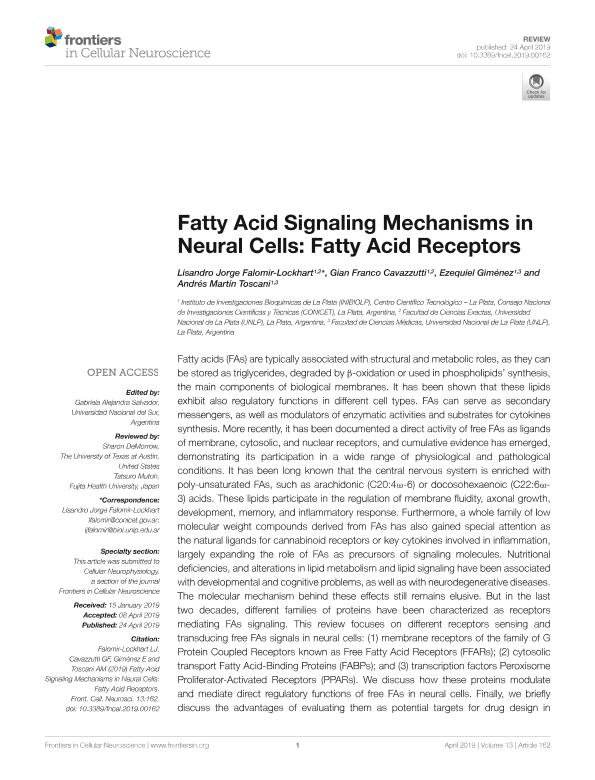Artículo
Fatty acid signaling mechanisms in neural cells: Fatty acid receptors
Falomir Lockhart, Lisandro Jorge ; Cavazzutti, Gian Franco; Giménez, Ezequiel
; Cavazzutti, Gian Franco; Giménez, Ezequiel ; Toscani, Andrés Martin
; Toscani, Andrés Martin
 ; Cavazzutti, Gian Franco; Giménez, Ezequiel
; Cavazzutti, Gian Franco; Giménez, Ezequiel ; Toscani, Andrés Martin
; Toscani, Andrés Martin
Fecha de publicación:
24/04/2019
Editorial:
Frontiers Media
Revista:
Frontiers in Cellular Neuroscience
e-ISSN:
1662-5102
Idioma:
Inglés
Tipo de recurso:
Artículo publicado
Clasificación temática:
Resumen
Fatty acids (FAs) are typically associated with structural and metabolic roles, as they can be stored as triglycerides, degraded by β-oxidation or used in phospholipids’ synthesis, the main components of biological membranes. It has been shown that these lipids exhibit also regulatory functions in different cell types. FAs can serve as secondary messengers, as well as modulators of enzymatic activities and substrates for cytokines synthesis. More recently, it has been documented a direct activity of free FAs as ligands of membrane, cytosolic, and nuclear receptors, and cumulative evidence has emerged, demonstrating its participation in a wide range of physiological and pathological conditions. It has been long known that the central nervous system is enriched with poly-unsaturated FAs, such as arachidonic (C20: 4ω-6) or docosohexaenoic (C22: 6ω-3) acids. These lipids participate in the regulation of membrane fluidity, axonal growth, development, memory, and inflammatory response. Furthermore, a whole family of low molecular weight compounds derived from FAs has also gained special attention as the natural ligands for cannabinoid receptors or key cytokines involved in inflammation, largely expanding the role of FAs as precursors of signaling molecules. Nutritional deficiencies, and alterations in lipid metabolism and lipid signaling have been associated with developmental and cognitive problems, as well as with neurodegenerative diseases. The molecular mechanism behind these effects still remains elusive. But in the last two decades, different families of proteins have been characterized as receptors mediating FAs signaling. This review focuses on different receptors sensing and transducing free FAs signals in neural cells: (1) membrane receptors of the family of G Protein Coupled Receptors known as Free Fatty Acid Receptors (FFARs); (2) cytosolic transport Fatty Acid-Binding Proteins (FABPs); and (3) transcription factors Peroxisome Proliferator-Activated Receptors (PPARs). We discuss how these proteins modulate and mediate direct regulatory functions of free FAs in neural cells. Finally, we briefly discuss the advantages of evaluating them as potential targets for drug design in order to manipulate lipid signaling. A thorough characterization of lipid receptors of the nervous system could provide a framework for a better understanding of their roles in neurophysiology and, potentially, help for the development of novel drugs against aging and neurodegenerative processes.
Archivos asociados
Licencia
Identificadores
Colecciones
Articulos(INIBIOLP)
Articulos de INST.DE INVEST.BIOQUIMICAS DE LA PLATA
Articulos de INST.DE INVEST.BIOQUIMICAS DE LA PLATA
Citación
Falomir Lockhart, Lisandro Jorge; Cavazzutti, Gian Franco; Giménez, Ezequiel; Toscani, Andrés Martin; Fatty acid signaling mechanisms in neural cells: Fatty acid receptors; Frontiers Media; Frontiers in Cellular Neuroscience; 13; 24-4-2019; 1-24
Compartir
Altmétricas



